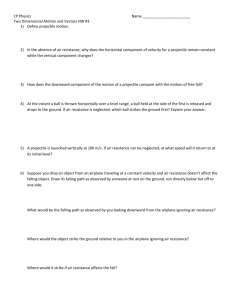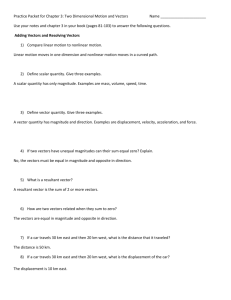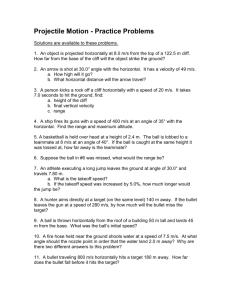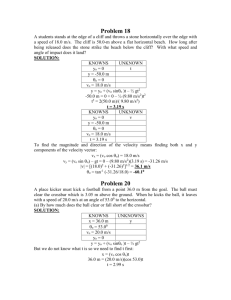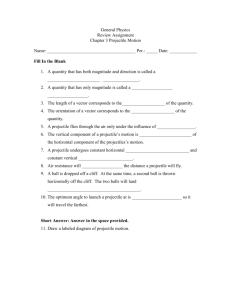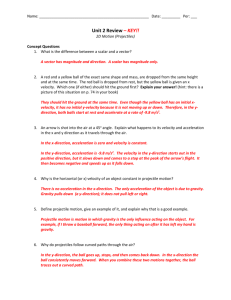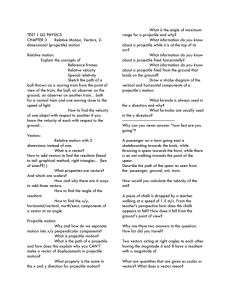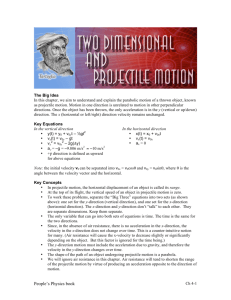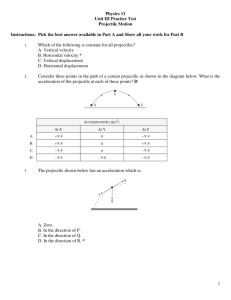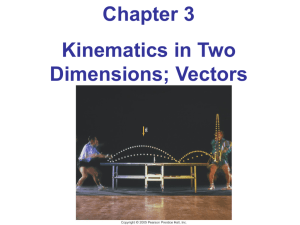Chapter 3: Two Dimensional Motion and Vectors (40 pts) Name Use
advertisement
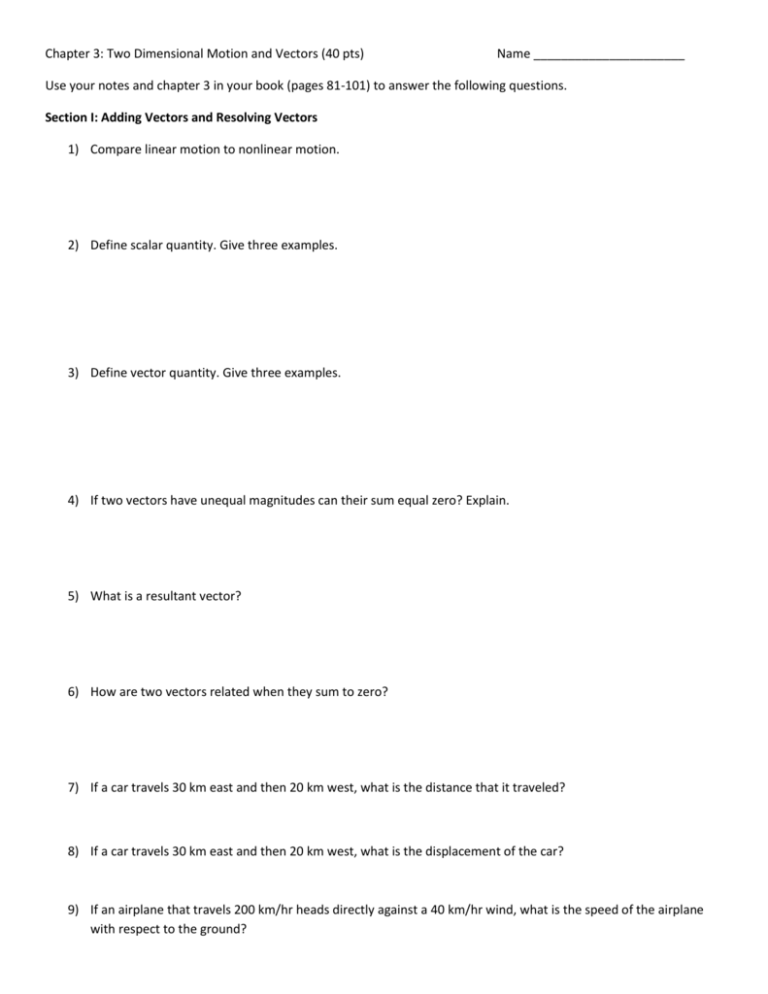
Chapter 3: Two Dimensional Motion and Vectors (40 pts) Name ______________________ Use your notes and chapter 3 in your book (pages 81-101) to answer the following questions. Section I: Adding Vectors and Resolving Vectors 1) Compare linear motion to nonlinear motion. 2) Define scalar quantity. Give three examples. 3) Define vector quantity. Give three examples. 4) If two vectors have unequal magnitudes can their sum equal zero? Explain. 5) What is a resultant vector? 6) How are two vectors related when they sum to zero? 7) If a car travels 30 km east and then 20 km west, what is the distance that it traveled? 8) If a car travels 30 km east and then 20 km west, what is the displacement of the car? 9) If an airplane that travels 200 km/hr heads directly against a 40 km/hr wind, what is the speed of the airplane with respect to the ground? 10) A vector making an angle of 45o to the horizontal has a magnitude of 141. What are the magnitudes of its horizontal and vertical components? For the following problems you must show your work including a drawing with the x-component, y-component and resultant vectors. 11) What is the velocity of a car traveling 120 km/hr east and then 200 km/hr south? 12) Find the components of the displacement of a person that walked 82 m at an angle 74o north of east. 13) You walk 2 km north, 6 km west, 3 km east, and then 8 km south. What is your displacement? 14) There is a 22.0 km wide river running north and south with a constant current of 12.0 km/hr south. A boat starts out at a constant velocity of 25.0 km/hr east. What is the velocity of the boat? 15) Find the x-component and y-component of an object moving at 34 m/s at an angle of 25o north of west. Section II: Projectile Motion 16) Why does a bowling ball move with only a little deceleration when it rolls along a bowling alley? 17) In the absence of air resistance, why does the horizontal component of velocity for a projectile remain constant while the vertical component changes? 18) How does the downward component of the motion of a projectile compare with the motion of free fall? 19) At the instant a ball is thrown horizontally over a level range, a ball held at the side of the first is released and drops to the ground. If air resistance is neglected, which ball strikes the ground first? Explain your answer. 20) A projectile is launched vertically at 100 m/s. If air resistance can be neglected, at what speed will it return to at its initial level? 21) Suppose you drop an object from an airplane traveling at a constant velocity and air resistance doesn’t affect the falling object. Draw its falling path as observed by someone at rest on the ground, not directly below but off to one side. What would be the falling path as observed by you looking downward from the airplane ignoring air resistance? Where would the object strike the ground relative to you in the airplane ignoring air resistance? Where would it strike if air resistance affects the fall? 22) A projectile is fired straight upward at 141 m/s. How fast is it moving upward at the instant it reaches the top of its trajectory? Suppose instead it were fired upward at a 45o angle. What would the y component of its speed be the top of its trajectory? For all of these problems ignore the effects of air resistance. Draw a picture to help you visualize the problem. Show all your work and the correct units for full credit. 23) A ball is projected horizontally off of the top of a cliff with a speed of 15 m/s. If the cliff is vertical and its height is 56 m, how long does it take the ball to hit the ground? 24) In the above problem, what horizontal distance from the base of the cliff does the ball land? 25) One crazy physics teacher was standing on top of tall building and wondered what the height of the building was. The teacher threw a physics book (that was all she ever carried) horizontally off the building at 4.0 m/s. The teacher found the book, open to chapter 3. The book was 16 meters from the base of the building. How long did it take the book to fall? 26) What is the height of the tall building? 27) Have you ever watched movie where people fall into a pool below their balcony? How long would it take to jump into the pool if it is 15 meters out from the bottom of their balcony that is 75 meters high? 28) For the above problem, how fast would a person have to jump horizontally to reach the pool instead of the pavement? 29) How high is a cliff if it takes 6 seconds for a rock to hit the ground below after the rock is thrown horizontally off the cliff? 30) Why doesn’t it matter how fast you throw the rock? Pythagorean Theorem C2 = A2 + B2 Sin θ = Opposite Hypotenuse Cos θ = Projectile Motion x- component y – component x v x t y 1 gt 2 2 t 2y g vx x t t x vx Adjacent Hypotenuse
